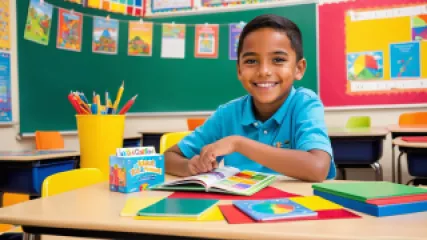How Special Education Programs Transformed My Child's Life
As a parent, the journey of raising a child can be filled with countless joys and challenges. When my son, Gabriel, was diagnosed with a learning disability at a young age, I was plunged into a world of uncertainty and worry. However, through special education programs, we found hope and solutions that transformed his life in remarkable ways. This is our story, a testament to the power of dedicated support, specialized tutoring, and innovative technology in special education.
The Initial Diagnosis
Gabriel was always a bright and curious child. He loved exploring the world around him, asking endless questions, and engaging in imaginative play. However, as he entered preschool, it became evident that he was struggling with certain tasks that came easily to his peers. Simple activities like recognizing letters, following multi-step instructions, and maintaining focus were particularly challenging for him.
Initially, I brushed off these concerns, attributing them to his unique personality. But as time passed, his difficulties became more pronounced, and it was clear that he needed help. After extensive evaluations by specialists, Gabriel was diagnosed with a learning disability that affected his ability to process information and communicate effectively.
The diagnosis was a turning point for our family. While it brought a sense of clarity, it also introduced a host of new questions and fears: How would Gabriel cope with school? Would he ever be able to keep up with his peers? What kind of future awaited him?
Finding the Right Support
Determined to give Gabriel the best possible chance at success, I began researching special education programs. I quickly learned that the key to helping children like Gabriel lies in providing individualized support tailored to their unique needs. This meant finding a program that could offer specialized instruction, one-on-one tutoring, and access to cutting-edge technology designed to assist with learning.
After much deliberation, we enrolled Gabriel in a special education program known for its comprehensive approach and experienced staff. The program's philosophy was rooted in the belief that every child has the potential to succeed, provided they receive the right support and encouragement.
Specialized Instruction: A Game Changer
The special education program introduced Gabriel to a new way of learning. Unlike traditional classrooms, which often follow a one-size-fits-all approach, the program focused on creating personalized learning plans for each student. These plans took into account Gabriel's strengths and weaknesses, allowing him to progress at his own pace.
One of the most significant changes was the emphasis on multi-sensory learning. For example, when teaching reading, the educators used a combination of visual, auditory, and tactile methods. Gabriel was encouraged to trace letters with his fingers, listen to phonetic sounds, and engage with colorful, interactive materials. This holistic approach made learning more accessible and enjoyable for him.
Moreover, the small class sizes ensured that Gabriel received ample individual attention. His teachers were able to identify his specific challenges and tailor their instruction accordingly. They also maintained regular communication with me, providing updates on his progress and offering strategies to support his learning at home.
The Role of Special Education Tutoring
In addition to specialized instruction, Gabriel benefited immensely from special education tutoring. His tutor, Michelle Byrd, was a seasoned professional with a deep understanding of learning disabilities. From the outset, Michelle established a strong rapport with Gabriel, making him feel comfortable and understood.
Michelle's tutoring sessions were a blend of academic support and confidence-building exercises. She broke down complex concepts into manageable steps and used creative techniques to keep Gabriel engaged. For instance, she incorporated games and storytelling into her lessons, which helped Gabriel grasp difficult subjects without feeling overwhelmed.
One of the most valuable aspects of Michelle's tutoring was her ability to adapt her teaching style to Gabriel's evolving needs. She continually assessed his progress and adjusted her methods accordingly. This flexibility ensured that Gabriel was always challenged but never discouraged.
Over time, the impact of Michelle's tutoring became evident. Gabriel's reading and math skills improved significantly, and he developed a newfound enthusiasm for learning. More importantly, his self-esteem soared as he realized that he was capable of achieving his goals with the right support.
Embracing Special Education Technology
Another pivotal element in Gabriel's journey was the integration of special education technology. The program utilized a range of tools designed to enhance learning and accommodate different abilities. For Gabriel, these technologies were nothing short of transformative.
One such tool was the use of text-to-speech software. This technology allowed Gabriel to listen to written text being read aloud, which greatly aided his comprehension. Additionally, speech-to-text applications enabled him to express his thoughts more effectively by dictating instead of writing.
Interactive educational apps also played a crucial role. These apps provided engaging and interactive content that reinforced classroom learning. Gabriel particularly enjoyed using apps that featured gamified learning experiences, where he could earn rewards for completing tasks and solving problems. This not only made learning fun but also motivated him to practice regularly.
Moreover, assistive technology devices, such as electronic organizers and timers, helped Gabriel develop better organizational and time-management skills. These tools provided visual and auditory reminders, ensuring that he stayed on track with his assignments and daily routines.
Building a Supportive Community
Beyond the classroom and tutoring sessions, the special education program fostered a sense of community among parents, educators, and students. This network of support was instrumental in Gabriel's progress and our family's overall well-being.
Regular parent-teacher meetings and workshops provided valuable insights into Gabriel's development and offered practical tips for supporting his learning at home. These gatherings also allowed us to connect with other families facing similar challenges, creating a shared space for exchanging experiences and advice.
The program also organized social events and extracurricular activities designed to promote inclusion and socialization. Gabriel participated in art classes, sports, and group projects, which helped him build friendships and develop essential social skills. These experiences were vital in boosting his confidence and fostering a sense of belonging.
The Transformative Impact
As Gabriel progressed through the special education program, the transformation in his life was nothing short of remarkable. The once-anxious and struggling child blossomed into a confident and capable learner. His academic achievements improved steadily, and he developed a genuine passion for subjects that had once seemed insurmountable.
One of the most heartwarming moments came when Gabriel proudly presented a science project at his school's annual fair. The project, which explored the solar system, was a culmination of months of hard work and determination. Gabriel's enthusiasm and knowledge impressed both his teachers and peers, and he received a special commendation for his efforts.
Beyond academics, Gabriel's overall well-being and self-esteem flourished. He no longer saw his learning disability as an insurmountable obstacle but rather as a part of who he was—a unique individual with his own strengths and talents.
Reflecting on the Journey
Looking back on our journey, I am filled with immense gratitude for the special education program that played such a pivotal role in Gabriel's life. The dedicated educators, personalized instruction, and innovative technology were all crucial elements in his success. However, it was the unwavering belief in his potential and the continuous support from the entire community that truly made the difference.
Our experience has taught us valuable lessons about the importance of early intervention, individualized support, and the power of a nurturing environment. It has also highlighted the need for increased awareness and advocacy for special education programs, so that more children like Gabriel can receive the support they need to thrive.
Conclusion: Hope and Possibility
Our story is just one of many, but it serves as a powerful reminder of the profound impact that special education programs can have on a child's life. Through specialized instruction, dedicated tutoring, and advanced technology, children with learning disabilities can overcome their challenges and achieve their full potential.
As parents, it is our responsibility to seek out the best possible resources and support for our children. By advocating for special education programs and embracing the tools and strategies they offer, we can help pave the way for a brighter future for all children, regardless of their abilities.
Gabriel's journey is a testament to the resilience of the human spirit and the transformative power of education. It is a journey that continues to inspire us every day, reminding us that with the right support and determination, anything is possible.






